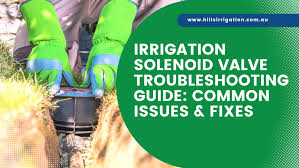A well-maintained sprinkler system is essential for efficient irrigation. However, issues can arise that impact its performance. This guide provides practical solutions for common sprinkler problems, empowering you to repair your system and maintain optimal operation.

Benefits of DIY Sprinkler Repair
- Cost Savings: Avoid expensive professional services.
- Quick Fixes: Resolve minor issues promptly.
- System Knowledge: Better understand your system for future maintenance.
Common Irrigation Sprinkler Problems and Solutions
1. Uneven Water Distribution
- Cause: Misaligned sprinkler heads or blocked nozzles.
- Solution:
- Adjust the angle and direction of sprinkler heads.
- Clean nozzles to remove debris.
2. Low Water Pressure
- Cause: Leaks, clogged pipes, or insufficient pump power.
- Solution:
- Check for visible leaks and repair them.
- Clear clogs using pipe-cleaning tools.
- Upgrade to a more powerful pump if necessary.
3. Sprinkler Heads Not Rotating
- Cause: Debris in the head’s gear mechanism.
- Solution:
- Disassemble the sprinkler head and clean its components.
- Replace damaged parts if cleaning doesn’t solve the issue.
4. Dry Spots in the Lawn
- Cause: Improper head spacing or blocked nozzles.
- Solution:
- Adjust the spacing between sprinkler heads for better coverage.
- Clean or replace blocked nozzles.
5. Constant Dripping from Sprinkler Heads
- Cause: Faulty valves or pressure regulation issues.
- Solution:
- Inspect and replace faulty valves.
- Install a pressure regulator to maintain optimal pressure.
6. Water Pooling Around Sprinklers
- Cause: Overwatering or leaks in the system.
- Solution:
- Adjust the watering schedule to reduce frequency.
- Repair leaks in pipes or fittings.

Essential Tools for Sprinkler Repair
- Screwdrivers (flathead and Phillips).
- Pipe cutter and repair fittings.
- Teflon tape for sealing threads.
- Shovel for accessing underground pipes.
- Replacement nozzles and valves.
Step-by-Step Guide for DIY Repairs
1. Identify the Problem
- Observe the system in operation.
- Look for visible leaks, irregular spray patterns, or malfunctioning heads.
2. Turn Off the Water Supply
- Shut off the main valve to prevent water flow during repairs.
3. Perform the Repair
- Replace damaged components (e.g., nozzles, valves, or heads).
- Patch leaks in pipes using repair couplings.
- Clear debris from clogged parts.
4. Test the System
- Turn the water supply back on.
- Check for proper operation and make additional adjustments as needed.
5. Maintain Your System
- Inspect and clean components regularly.
- Adjust the system seasonally for changing watering needs.
User Feedback on DIY Sprinkler Repairs
John, Homeowner: “Fixing a leaky pipe myself saved me hundreds of dollars. The process was easier than I expected.”
Ella, Gardener: “Cleaning my clogged nozzles restored my system’s performance in no time.”
Mark, Landscaper: “Identifying low pressure and replacing a faulty valve significantly improved coverage on a client’s lawn.”
Pro Tips for Successful Repairs
- Document Your System: Keep a layout of pipes and sprinkler heads for easier troubleshooting.
- Invest in Quality Parts: Use durable components to reduce future maintenance needs.
- Winterize Properly: Drain the system and protect parts during freezing conditions.

Conclusion
DIY irrigation sprinkler repair is a valuable skill that saves money and ensures a healthy, well-maintained lawn or garden. By troubleshooting common issues and performing regular maintenance, you can extend the life of your system and achieve optimal watering efficiency. Take charge of your sprinkler system today!





